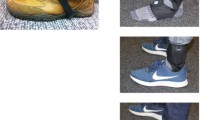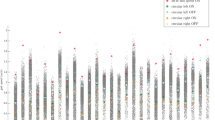Abstract
Clinical trials need to specify which specific gait characteristics to monitor as mobility measures for each neurological disorder. As a first step, this study aimed to investigate a set of measures from daily-life monitoring that best discriminate mobility between people with multiple sclerosis (MS) and age-matched healthy control subjects (MS-Ctl) and between people with Parkinson’s disease (PD) and age-matched healthy control subjects (PD-Ctl). Further, we investigated how these discriminative measures relate to the disease severity of MS or PD. We recruited 13 people with MS, 21 MS-Ctl, 29 people with idiopathic PD, and 20 PD-Ctl. Subjects wore 3 inertial sensors on their feet and the lumbar back for a week. The Area Under Curves (AUC) from the receiver operator characteristic (ROC) plot was calculated for each measure to determine the objective measures that best separated the MS and PD groups from their respective control cohorts. Adherence wearing the sensors was similar among groups for 58–66 h of recording (p = 0.14). Quantity of mobility (activity measures, such as a median number of strides per gait bout, AUC = 0.93) best discriminated mobility impairments in MS from MS-Ctl. In contrast, quality of mobility (such as turn angle, AUC = 0.90) best discriminated mobility impairments in PD from PD-Ctl. Mobility measures with AUC > 0.80 were correlated with MS and PD clinical scores of disease severity. Thus, measures characterizing mobility impairments differ for MS versus PD during daily life suggesting that mobility measures for clinical trials and clinical practice need to be specific to each neurological disorder.



Similar content being viewed by others
References
Nutt JG, Marsden CD, Thompson PD (1993) Human walking and higher-level gait disorders, particularly in the elderly. Neurology 43(2):268–279
Snijders AH, Van De Warrenburg BP, Giladi N, Bloem BR (2007) Neurological gait disorders in elderly people: clinical approach and classifi cation. Lancet Neurol 6(1):63–74
Baker JM (2018) Gait disorders. Am J Med 131(6):602–607
Studenski S et al (2011) Gait speed and survival in older adults. JAMA 305(1):50–58
Block VAJ, Pitsch E, Tahir P, Cree BAC, Allen DD, Gelfand JM (2016) Remote physical activity monitoring in neurological disease: a systematic review. PLoS ONE 11(4):e0154335
Hale LA, Pal J, Becker I (2008) Measuring free-living physical activity in adults with and without neurologic dysfunction with a triaxial accelerometer. Arch Phys Med Rehabil 89(9):1765–1771
Chastin SFM, Baker K, Jones D, Burn D, Granat MH, Rochester L (2010) The pattern of habitual sedentary behavior is different in advanced Parkinson’s disease. Mov Disord 25(13):2114–2120
Weiss A, Sharifi S, Plotnik M, Van Vugt JPP, Giladi N, Hausdorff JM (2011) Toward automated, at-home assessment of mobility among patients with Parkinson disease, using a body-worn accelerometer. Neurorehabil Neural Repair 25(9):810–818
Cavanaugh JT, Ellis TD, Earhart GM, Ford MP, Foreman KB, Dibble LE (2012) Capturing ambulatory activity decline in Parkinson’s disease. J Neurol Phys Ther 36(2):51–57
Lord S, Godfrey A, Galna B, Mhiripiri D, Burn D, Rochester L (2013) Ambulatory activity in incident Parkinson’s: more than meets the eye? J Neurol 260(12):2964–2972
Weiss A et al (2013) Does the evaluation of gait quality during daily life provide insight into fall risk? A novel approach using 3-day accelerometer recordings. Neurorehabil Neural Repair 27(8):742–752
Weiss A, Herman T, Giladi N, Hausdorff JM (2014) Objective assessment of fall risk in Parkinson’s disease using a body-fixed sensor worn for 3 days. PLoS ONE 9(5):e96675
El-Gohary M et al (2014) Continuous monitoring of turning in patients with movement disability. Sensors (Switzerland) 14(1):356–369
Wallen MB, Franzen E, Nero H, Hagstromer M (2015) Levels and patterns of physical activity and sedentary behavior in elderly people with mild to moderate parkinson disease. Phys Ther 95(8):1135–1141
Mancini M et al (2015) Continuous monitoring of turning in Parkinson’s Disease: rehabilitation potential. Neuro Rehabil 37(1):3–10
Del Din S, Godfrey A, Galna B, Lord S, Rochester L (2016) Free-living gait characteristics in ageing and Parkinson’s disease: impact of environment and ambulatory bout length. J Neuroeng Rehabil 13(1):1–12
Mancini M et al (2016) Continuous monitoring of turning mobility and its association to falls and cognitive function: a pilot study. J Gerontol Ser A Biol Sci Med Sci 71(8):1102–1108
Bernad-Elazari H, Herman T, Mirelman A, Gazit E, Giladi N, Hausdorff JM (2016) Objective characterization of daily living transitions in patients with Parkinson’s disease using a single body-fixed sensor. J Neurol 263(8):1544–1551
De Lima ALS et al (2017) Feasibility of large-scale deployment of multiple wearable sensors in Parkinson’s disease. PLoS ONE 12(12):1–15
Adams JL et al (2017) Multiple wearable sensors in Parkinson and Huntington disease individuals: a pilot study in clinic and at home. Digit Biomark 1(1):52–63
Lipsmeier F et al (2018) Evaluation of smartphone-based testing to generate exploratory outcome measures in a phase 1 Parkinson’s disease clinical trial. Mov Disord 33(8):1287–1297
Arora S et al (2018) Smartphone motor testing to distinguish idiopathic REM sleep behavior disorder, controls, and PD. Neurology 91(16):e1528–e1538
Zhan A et al (2018) Using smartphones and machine learning to quantify Parkinson disease severity the mobile Parkinson disease score. JAMA Neurol 75(7):876–880
Mancini M, Weiss A, Herman T, Hausdorff JM (2018) Turn around freezing: community-living turning behavior in people with Parkinson’s disease. Front Neurol 9:1–9
Del Din S, Godfrey A, Mazzà C, Lord S, Rochester L (2016) Free-living monitoring of Parkinson’s disease: lessons from the field. Mov Disord 31(9):1293–1313
Boucą-Machado R, Maetzler W, Ferreira JJ (2018) What is functional mobility applied to Parkinson’s disease? J Parkinsons Dis 8(1):121–130
Zampieri C, Salarian A, Carlson-Kuhta P, Aminian K, Nutt JG, Horak FB (2010) The instrumented timed up and go test: potential outcome measure for disease modifying therapies in Parkinson’s disease. J Neurol Neurosurg Psychiatry 81(2):171–176
Lord S, Galna B, Verghese J, Coleman S, Burn D, Rochester L (2013) Independent domains of gait in older adults and associated motor and nonmotor attributes: validation of a factor analysis approach. J Gerontol Ser A 68(7):820–827
Morris R, Hickey A, Del Din S, Godfrey A, Lord S, Rochester L (2017) A model of free-living gait: a factor analysis in Parkinson’s disease. Gait & Posture 52:68–71
Maetzler W, Domingos J, Srulijes K, Ferreira JJ, Bloem BR (2013) Quantitative wearable sensors for objective assessment of Parkinson’s disease. Mov Disord 28(12):1628–1637
Kowal SL, Dall TM, Chakrabarti R, Storm MV, Jain A (2015) Digital health revolution: is it time for affordable remote monitoring for Parkinson’s disease? Front Neurol 6(34):1–3
Espay AJ et al (2019) A roadmap for implementation of patient-centered digital outcome measures in Parkinson’s disease obtained using mobile health technologies. Mov Disord Clin Pract 34(5):657–663
Fischer JS, Rudick RA, Cutter GR, Reingold SC, Ms N, Clinical S (1999) The multiple sclerosis functional composite measure (MSFC): an integrated approach to MS clinical outcome assessment. Mult Scler J 5(4):244–250
Motl RW, Cohen JA, Benedict R, Phillips G, Larocca N (2017) Validity of the timed 25-foot walk as an ambulatory performance outcome measure for multiple sclerosis. Mult Scler J 23(5):704–710
Kurtzke JF (1983) Rating neurologic impairment in multiple sclerosis : an expanded disability status scale (EDSS). Neurology 33(11):1444–1453
Collins CDE et al (2016) A comparative analysis of patient-reported expanded disability status scale tools. Mult Scler J 22(10):1349–1358
Hobart JC, Riazi A, Lamping DL, Fitzpatrick R, Thompson AJ (2003) Measuring the impact of MS on walking ability the 12-item MS walking scale ( MSWS-12). Neurology 60(1):31–36
Flachenecker P, Ku T, Kallmann B, Gottschalk M, Grauer O, Rieckmann P (2002) Fatigue in multiple sclerosis: a comparison of different rating scales and correlation to clinical parameters. Mult Scler J 8(6):523–526
Goetz CG et al (2008) Movement disorder society-sponsored revision of the unified Parkinson’s disease rating scale (MDS-UPDRS): scale presentation and clinimetric testing results. Mov Disord 23(15):2129–2170
Shah VV, McNames J, Mancini M, Carlson-Kuhta P, Nutt JG, El-Gohary M, Lapidus JA, Horak FB, Curtze C, Digital biomarkers of mobility in Parkinson’s disease during daily living. (under review)
Mancini M, King L, Salarian A, Holmstrom L, McNames J, Horak FB (2011) Mobility lab to assess balance and gait with synchronized body-worn sensors. J Bioeng Biomed Sci, Suppl 1, 007. https://doi.org/10.4172/2155-9538.S1-007
Washabaugh EP, Kalyanaraman T, Adamczyk PG, Claflin ES, Krishnan C (2017) Validity and repeatability of inertial measurement units for measuring gait parameters. Gait & Posture 55:87–93
Morris R, Stuart S, McBarron G, Fino PC, Mancini M, Curtze C (2019) Validity of mobility lab (version 2) for gait assessment in young adults, older adults and Parkinson’s disease. Physiol Meas 40(9):095003
Wan EA, van der Merwe R (2000) The unscented kalman filter for nonlinear estimation. In: Proceedings of the IEEE 2000 Adaptive Systems for Signal Processing, Communications, and Control Symposium (Cat. No.00EX373), pp 153–158
van der Merwe R (2004) Sigma-point kalman filters for probabilistic inference in dynamic state-space models. Oregon Health & Science University (Doctoral dissertation, OGI School of Science & Engineering at Oregon Health & Science University)
Fawcett T (2006) An introduction to ROC analysis. Pattern Recognit Lett 27(8):861–874
Turck N et al (2011) pROC: an open-source package for R and S+ to analyze and compare ROC curves. BMC Bioinform 8:12–77
Giggins OM, Clay I, Walsh L (2017) Physical activity monitoring in patients with neurological disorders: a review of novel body-worn devices. Digit Biomark 4:14–42
Cavanaugh JT, Gappmaier VO, Dibble LE, Gappmaier E (2011) Ambulatory Activity in Individuals With Multiple Sclerosis. Journal of neurologic physical therapy 4103:26–33
Erin SM, Motl RW, Gliottoni RC (2009) The effect of walking mobility on the measurement of physical activity using accelerometry in multiple sclerosis. Clin Rehabil 23(3):248–258
Leach JM, Mellone S, Palumbo P, Bandinelli S, Chiari L (2018) Natural turn measures predict recurrent falls in community-dwelling older adults: a longitudinal cohort study. Sci Rep 8(1):1–9
Hausdorff JM, Cudkowicz ME, Firtion R (1998) Gait variability and basal ganglia disorders: stride-to-S tride variations of gait cycle timing in Parkinson’s disease and Huntington’s disease. Mov Disord 13(3):428–437
Busse ME, Pearson OR, Van Deursen R, Wiles CM (2004) Quantified measurement of activity provides insight into motor function and recovery in neurological disease. J Neurol Neurosurg Psychiatry 75(6):884–888
Prince F, Hkbert R, Winter A (1997) Gait in the elderly. Gait & Posture 5:128–135
Pirker W, Katzenschlager R (2017) Gait disorders in adults and the elderly. Wien Klin Wochenschr 129(3–4):81–95
Acknowledgements
We thank our participants for generously donating their time to participate and Graham Harker for helping with data collection. This study was supported by the National Multiple Sclerosis Society Mentor Fellowship (MB0027), and National Institutes of Health grants from the National Institute on Aging (#R44AG055388 and #R43AG044863).
Author information
Authors and Affiliations
Corresponding author
Ethics declarations
Conflicts of interest
Drs. McNames, El-Gohary, and Horak have a significant financial interest in APDM, a company that may have a commercial interest in the results of this research and technology. Dr. Horak also consults with Biogen, Neuropore, Sanofi, and Takeda. This potential conflict has been reviewed and managed by OHSU.
Ethical standards
This study was conducted in accordance with the standards and approved by local human subjects ethics committees, and has been performed in accordance with the ethical standards laid down in the 1964 Declaration of Helsinki and its later amendments. All subjects provided informed written consent prior to their inclusion in the study.
Electronic supplementary material
Below is the link to the electronic supplementary material.
Rights and permissions
About this article
Cite this article
Shah, V.V., McNames, J., Mancini, M. et al. Quantity and quality of gait and turning in people with multiple sclerosis, Parkinson’s disease and matched controls during daily living. J Neurol 267, 1188–1196 (2020). https://doi.org/10.1007/s00415-020-09696-5
Received:
Revised:
Accepted:
Published:
Issue Date:
DOI: https://doi.org/10.1007/s00415-020-09696-5




